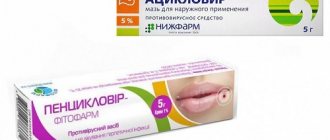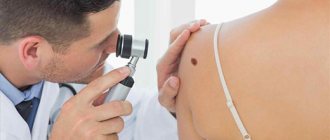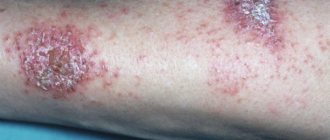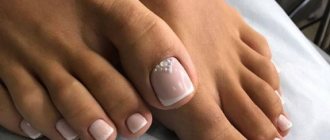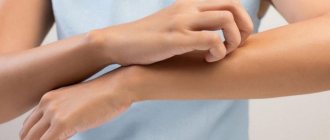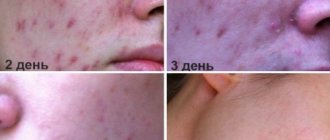The International Health Center provides a wide range of medical services. Highly qualified specialists remove papillomas using the Surgitron device. A radio wave knife allows you to quickly and safely get rid of the manifestations of the disease.
The human papillomavirus appears as small lesions that appear on the skin. In order to prevent the progression and spread of the disease, surgical correction is recommended.
The working principle of a radio wave knife
Surgitron works by generating high frequency radio waves. When exposed to the human body, they lead to the evaporation of fluid from cells (skin or mucous membranes). In fact, we can say that only the cells themselves evaporate, while the areas surrounding them remain completely intact, the radio wave does not affect them.
The accumulation of high-frequency energy occurs at the very end of the active electrode. When a doctor points such a surgical instrument at tissues, they are exposed to high-frequency waves. As a result of tissue resistance, heat is released, which causes the cutting effect. There is a surge of intracellular molecular energy, heating the tissue and evaporating the cells.
Due to its minimal effect on nearby tissues, Surgitron extremely rarely causes scarring on the skin.
It is often used for interventions on the face and delicate areas of the genital organs, in particular on the cervix.
Concept and history of creation
Surgitron is a device for radiosurgery. The American-made unit does not involve mechanical impact on the patient’s body. Distinctive features: maximum precision without damaging soft tissues. Features of the method include:
- no side effect such as bleeding;
- safe tissue disinfection;
- operates without contact;
- easy to control the penetration depth of the impact;
- minimal postoperative recovery period;
- the manipulation takes place without psychological stress, in the most comfortable environment for patients;
- minimal swelling.
The history of its origin dates back to 1973, when the American dentist and radio engineer Ellman Irving was able to prove the dependence of the severity of tissue damage on the frequency of the applied electric current. The optimal value that causes the least damage was 3.8 - 4.0 MHz. Based on this knowledge, the Surgitron generator was created and patented. The doctor’s discovery gave birth to a new term in medicine “radiofrequency (radio wave) surgery.” The first device had 4 waveforms.
Advantages
Using the Surgitron device has many advantages:
- Manipulations with such a device are performed quickly.
- The surrounding tissue is not burned or otherwise damaged.
- The operation is not accompanied by bleeding - the dissected vessels are immediately cauterized.
- There is no risk of purulent complications - the operation is completely safe from the point of view of infection of postoperative wounds and infection during the intervention.
- During and after the intervention, the patient feels virtually no discomfort. The tissue around the postoperative wound swells to a minimum.
- After the operation, the patient recovers quickly.
- When using a radioknife, it is possible to remove material for histological examination.
- The risk of scarring after surgery is minimal.
Surgical interventions using the Surgitron device are minimally traumatic. Due to the presence of a significant selection of electrodes in the device, it is possible to remove various tumors on various areas of the body, including the face and mucous membranes.
Preparation for the procedure
Before the operation, patients should consult with their doctor, learn about all the features of the manipulation, possible consequences, and recovery period. Preparatory measures include:
- a visit to a gynecologist who performs an initial visual examination, a smear for infections and flora;
- passing standard preoperative tests (for infections, biochemistry, hormones);
- at the doctor’s discretion, colposcopy, cytology and transvaginal ultrasound may be prescribed;
- you should abstain from sexual intercourse at least 2 days in advance;
- do not insert tampons or medications into the vaginal area;
- conducting an allergy test if sensitivity to medications used during manipulation is suspected;
- make sure there is no pregnancy.
The primary task before surgery is to determine the nature of the neoplasm: malignant or benign. This is followed by maximum clarification of the localization of pathological foci.
Does it hurt or not?
When performing various medical procedures using Surgitron, local anesthesia is performed - a spray with an anesthetic is used, local injections with an anesthetic drug are performed, or special creams are used. As a result, the operation is completely painless. The patient may feel only minor discomfort.
After the intervention, pain also does not bother patients.
Stages of ingrown toenail disease
- Without inflammation Mild pain during walking, inflammatory reaction of the soft tissues of the cushion in the form of slight swelling and redness.
- With inflammation Pain, increased redness and swelling of tissues, the occurrence of an inflammatory process
- Inflammation, suppuration, the appearance of granulations Pain, swelling of the lateral ridges, suppuration, swelling of the entire nail phalanx of the finger, the appearance of the formation of a bloody-purulent granuloma (“wild meat”)
- 1
- 2
Scope of application
Radiosurgery treatment is excellent for:
- Treatment of various dermatological ailments, in particular, to remove tumors on the skin.
- Therapy of gynecological diseases.
- Scar plastic surgery.
- Treatment of certain dental problems.
- Stopping capillary bleeding, for example, during surgical interventions.
Only a doctor can determine whether Surgitron can be used in each specific case or whether it is better to give preference to another type of surgical intervention.
What's better?
Radio wave treatment is considered one of the most progressive methods of modern dermatology and gynecology. But at the same time, disputes arise among patients, and sometimes even among doctors, which method is still preferable.
Laser
Both laser and Surgitron have a similar effect on the skin. Both devices do not directly touch the skin and allow you to get rid of the problem quickly and without pain. The recovery period after such interventions is approximately the same. But many doctors still prefer radio wave treatment, because:
- When using Surgitron, the surrounding tissues do not heat up at all. At the same time, the laser beam can cause burns to nearby healthy cells. There is information online that the degree of trauma to surrounding tissues when using the Surgitron device is two to three times less than when using a laser.
- When using a radioknife, the surgeon has more control over the intervention. This statement is difficult to explain, but for a practicing physician it is important to feel the depth of the device’s impact not only visually (as when using a laser), but also tactilely (holding the electrode in your hand).
- The wound after radio wave treatment still heals a little faster.
- When using a radioknife, it is possible to submit the removed material for histological analysis; when using a laser, this is almost impossible.
With high skill of the surgeon, both laser and radio wave treatment will be effective and safe. Therefore, when choosing a method for removing tumors and other problems, you must first select a doctor and a clinic.
Greenland or Ellman Rus?
Medical institutions can use various devices for radio wave treatment. Among the most popular are devices of the Greenland and Surgitron brands from the distributor ELLMAN-RUS. For an ordinary patient, it makes no fundamental difference which device will be used to perform the intervention. Both options give excellent results. But practitioners, when choosing equipment for their clinic, often prefer the more powerful Greenland RFS4000K device over the Surgitron Dual EMC 90. Greenland is different:
- Higher cutting power, monopolar and bipolar coagulation, as well as fulgation.
- The ability to record the latest working settings in memory.
- Possibility of use for radio wave lifting in cosmetology.
- Possibility of use for microdiscectomy in spinal surgery.
- Longer warranty period.
Cost is also a fairly important criterion when choosing. Greenland is significantly cheaper than Surgitron.
Radiosurgical removal in dermatology
The radio wave treatment method is widely used in dermatological practice to get rid of:
- Papillomas and warts of various localizations.
- Nevi (moles).
- Various benign formations, represented by keratomas, fibromas, lipomas and atheromas.
- Molluscum contagiosum (even in children).
- Genital warts.
Method of treatment
A radioknife treatment session takes no more than half an hour, while the device itself acts on the skin for only a couple of minutes, and sometimes less. The entire removal process consists of several main steps:
- The nurse treats the skin with an antiseptic.
- Local anesthesia is performed using a pre-selected anesthetic.
- Wait about three to five minutes for the anesthetic to take effect.
- The doctor picks up the tip of the device (a round waveguide in a loop), turns on the device itself and quite quickly removes tumors on the skin or mucous membranes. If there is a need to send material for histology, doctors cut off skin defects in one movement - at the root. If there is no such need, the specialist simply evaporates the problematic tumor layer by layer (in this case, the doctor clearly controls the depth of exposure).
- After direct removal, the specialist can smoothly smooth the wound on the skin with another waveguide—a ball waveguide. The tissues are finally smoothed and cauterized to prevent bleeding.
- After completing the removal, the doctor treats the wound and surrounding skin with an antiseptic.
Doctors make sure to give patients detailed information on how to properly care for the area where the tumor was located so that the wound heals well and scars do not appear on the skin
It is necessary to protect the wound from damage and exposure to negative factors until the crust falls off.
Contraindications
Removal of any skin tumors is not carried out if the patient has various conditions that are a contraindication to any elective surgery:
- Excessively high pressure.
- Decompensated diabetes mellitus.
- Heart attack.
- Epilepsy.
- Any inflammatory and infectious diseases.
- Herpes.
- High body temperature.
The following are contraindications to the use of radioknife on the skin:
- Various skin diseases (chronic in the acute stage and acute).
- Suspicion of malignancy of the neoplasm.
It is important to consider that the radioknife cannot be used on any part of the body if the patient has a pacemaker. When performing an intervention, it is necessary to turn off or remove all electrical devices (for example, a hearing aid, etc.).
Rehabilitation period
The rehabilitation period after removal of moles or warts in the absence of serious complications lasts only a week. Wound healing can be done dry or wet. The second option is considered more preferable for many, as it prevents the damaged skin from drying out and crusting over. In addition, moist healing eliminates the possibility of scarring.
With the wet healing method, the doctor will prescribe medicinal ointments
If a doctor has recommended a wet healing method to his patient, he will additionally prescribe a number of medicinal products in the form of ointments. They are applied to the location of the former papilloma. It is advisable, after treating the wound with ointment, to cover it with an adhesive plaster that does not allow air to pass through.
To shorten the healing process of the wound after removing a skin growth using the Surgitron device, you must adhere to the following recommendations:
- The first few days you need to monitor the condition of the skin damaged during the operation. The patient should palpate the epithelium independently. This way he will be able to promptly identify the presence of unnatural seals. If they are detected, the patient should immediately consult a doctor;
- The wound should be washed with water at room temperature with the addition of a small amount of soap;
- It is advisable to prevent the appearance of a crust on the wound. If it has already become covered with skin, then under no circumstances should you tear off the growth. You need to wait until it disappears on its own. This will happen after the wound has completely healed;
- It is forbidden to cover the area where a papilloma or mole was previously located with cosmetics until it has completely healed;
- The patient will have to give up going to the pool, sauna and bathhouse. During water procedures and steaming the skin, the likelihood of infection of the wound increases several times;
- Visits to solariums and beaches are prohibited. Patients who have undergone wart removal using the radio wave method should avoid sunbathing;
- It is advisable to avoid strenuous physical activity. Under no circumstances should pressure be applied to the wound itself.
To speed up the healing of the wound, avoid serious physical activity!
If discomfort is felt in the area affected by Surgitron, you should immediately consult a doctor. It is possible that the wound has become infected. If it is not eliminated, tissue and blood infection will begin. All this will have a detrimental effect on the general health of the patient.
If the patient follows all the specialist’s recommendations, then within a few days his wound will almost completely heal and will no longer cause him discomfort.
The site of the former growth will be covered with skin that has a pink tint. Over time it will acquire a more natural color.
Radio wave scalpel in gynecology
The radio wave treatment technique is also popular among gynecologists, because it makes it possible to quickly and effectively deal with:
- Ectopia and ectropion of the uterine cervix.
- Cicatricial changes in the uterine cervix, for example, after ruptures during labor.
- Leukoplakia.
- Endometriosis of the uterine cervix.
- Cervical intraepithelial neoplasia (now this term is used to refer to dysplasia or erosion of the uterine cervix).
- Genital and anal papillomas (condylomas) and moles.
- Polyps in the cervical canal.
- Cysts of the uterine cervix.
The radioknife method can also be used to perform a cervical biopsy.
Cauterization of cervical erosion
Cauterization or excision of the uterine cervix is a relatively simple procedure that can be performed when the patient visits the doctor's office (without any hospitalization). Immediately after treatment, the woman can go home. The intervention is performed in several stages:
- The patient is positioned on a gynecological chair.
- The doctor administers local anesthesia (usually a spray is used for this purpose).
- First, the specialist removes the pathological areas with a loop electrode. Most often, one pass is enough for this.
- Afterwards, the wound is treated with a ball electrode, due to which the wound is leveled and the vessels are cauterized (coagulated).
- The operated area is treated with an antiseptic, for example, a chlorhexidine solution.
Recovery after such manipulation has some peculiarities. In particular, on the first day the patient may feel some pain in the lower abdomen, and after 4–5 days she will experience minor bleeding. Such symptoms are completely normal and should be reported to your doctor.
If there are any disturbances in the healing and recovery process, you should seek medical help.
Contraindications
General contraindications for the use of radioknife in gynecology remain the same as those listed above (fever, ARVI symptoms, etc.). But there are a number of conditions that can prevent cauterization of erosion. Among them:
- Menstruation. Cauterization is carried out on certain days of the cycle with prior agreement with the doctor.
- Uterine bleeding of unknown etiology.
- A certain degree of vaginal cleanliness (confirmed by tests).
- Diseases of the vagina, cervix, and internal genital organs (especially inflammatory ones).
The possibility of radio wave treatment in each specific case is determined individually.
Method of treatment with the Surgitron device
Removal of moles with Surgitron, warts, and cervical erosion is performed on an outpatient basis. The patient must first undergo some tests and, if necessary, be examined by a doctor. The general procedure for treatment with Surgitron is as follows:
- The patient is given a position convenient for the manipulation.
- The desired area is numbed. As a rule, local anesthesia is used using solutions of Novocaine, Lidocaine or special anesthetics in the form of aerosols and ointments. If the procedure must be performed on a young child, it is recommended to use intravenous anesthesia.
- Performing the manipulation itself.
- Treatment of the operated area with antiseptics.
- Apply a sterile dressing, if necessary.

